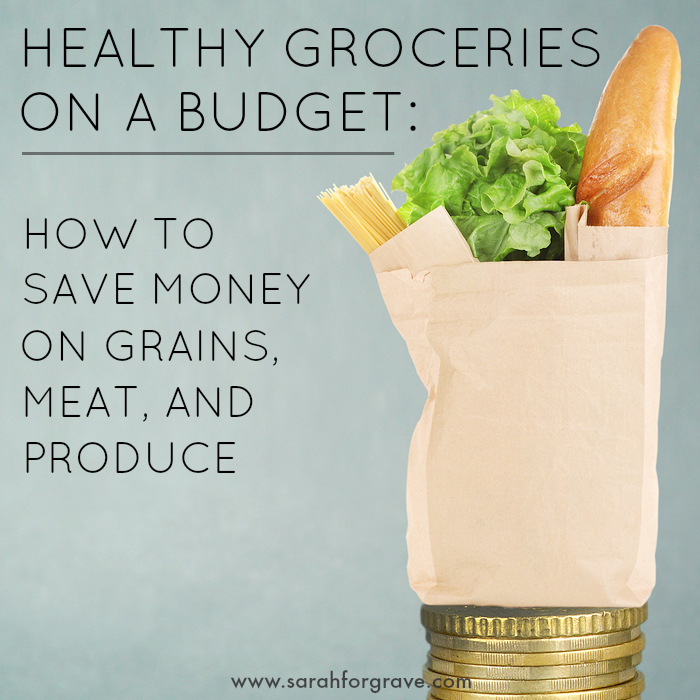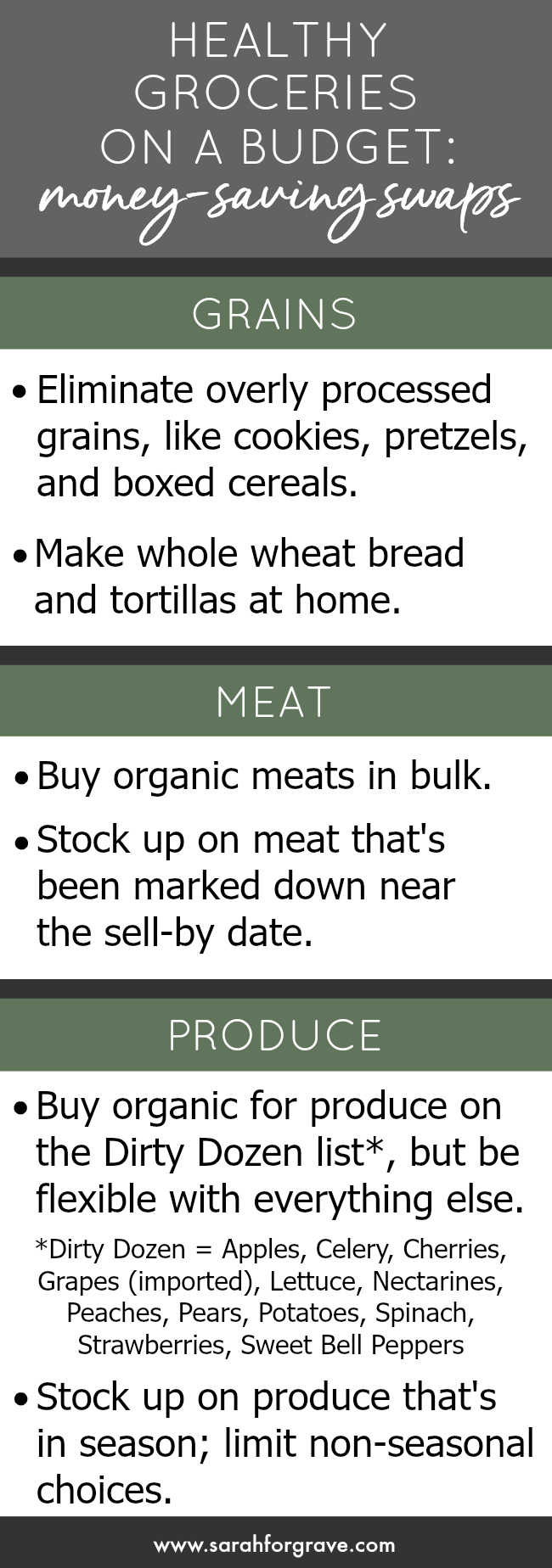Last week I started a new series called “Healthy Groceries on a Budget.” If you didn’t catch last week’s post, I shared my personal parameters for a healthy grocery cart, including how I read nutrition labels.
Today I’m focusing on specific areas where I save money at the store.
For starters, let’s talk about some common processed foods that frequented my grocery cart in my “pre-healthy” days. Many of these have been eliminated from my kitchen altogether (aside from the occasional treat for my hubby and kids).
- Oreos $2.99
- Vanilla wafers $4.49
- Teddy grahams $3.19
- Peanut-butter filled pretzels $3.79
- 1/2 Gallon of orange juice $2.59 [I buy fresh oranges instead.]
- Chips $2.99
- Sugary cereals $2-$4 per box
As you can see, the costs add up (over $20 total for the foods in this list)! And it doesn’t even include frozen meals and other junk food I bought on a regular basis too. By eliminating these items from my cart, my budget is freer to invest in healthier options. Not only that, but the healthier options fill my stomach longer so I don’t need to revisit the pantry as often. Win-win!
Okay, so let’s dive into more details of where I save money at the grocery store.
GRAINS
Most weeks, I buy whole grain bread or tortillas at the store, thanks to the savings I gain by not buying the foods listed above. (A quick reminder about my rule of thumb on ingredients: The contents have to be easily understood and as close to their natural state as possible. No long list of preservatives.) 🙂
If money is tight and I have extra time on my hands, I like to make bread and tortillas at home. This whole wheat bread recipe is simple to make in the bread machine and costs around $1.50 per loaf, compared to a similar loaf at the store that can cost anywhere between $3-$5. This whole wheat tortilla recipe costs 64 cents for a batch of 8 tortillas, versus the $4 price tag at my local grocery store for a highly processed equivalent.
MEAT
I try to buy organic meats whenever possible, but it doesn’t always fit in my budget for the week. One way I work around this is to buy meat in bulk at Costco. Their organic ground beef is an especially great deal, beating out its non-organic counterparts per pound at the regular grocery store.
Another way I save money is to buy meat when it’s been marked down. Usually stores mark their meat down when it nears the sell-by date. The meat is still good; the store just has to take it off their shelves within a couple days, so they try to offload it by marking down the price. When I find these deals, I stock up. I bring the meat straight home to my freezer and incorporate it into a meal later in the month.
FRUITS AND VEGGIES
Similar to meats, I prefer to buy organic produce, but I have to be flexible depending on availability. If all else fails, I always buy the “Dirty Dozen” foods in organic form whenever possible. This is especially true for foods that my family eats in gobs, like apples. (By the way, my experiment actually proved that organic apples were cheaper than their non-organic counterparts. More on that next week!)
Another way I save money is to buy produce that’s in season. I still buy non-seasonal produce all year long (apples, anyone? :)), but stocking up on seasonal items gives more wiggle room in the budget for those non-seasonal must-haves.
Before we wrap up, I have one more budget tip. But first, here’s a Pinterest-friendly summary of what we’ve covered…
All right, now for the bonus tip…
If you’re trying new recipes, beware of spending half your grocery budget on oddball ingredients you might only use once.
Case in point: A few years ago, I decided to try a really unique, super-healthy cookie recipe. It called for all sorts of unusual ingredients, including a type of flour I could only find at a specialty market. I spent a small fortune on this flour, only to discover that my family hated the cookies after I made them. In retrospect, I would have done a little research to see what I already had in my pantry and substituted it in place of the expensive flour (which, by the way, ended up being thrown out a few months later).
Bottom line: Be your own detective!
You may not have time to track your grocery spending to the penny, but you can keep an eye on your patterns. What costs the most? Does it promote health, or does it damage it? If it damages your health, that’s the first place to start when deciding what to eliminate from your list. I promise you WILL survive without that package of cookies! (I’m living proof — 3 years with no Oreos and still going strong. :))
ONE SIMPLE STEP: Cross out one unhealthy item on your grocery list this week and replace it with a healthy alternative. (i.e., Instead of buying a package of Oreos, buy extra fruit that’s on sale.)
ONE STEP FURTHER: Why stop at one? Pick a few more unhealthy foods that can be crossed off your list and find healthy alternatives for each.
Grocery bag photo by Yastremska/BigStock.com

